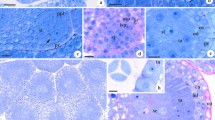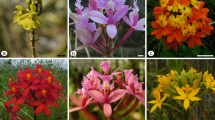Abstract
In this study, we performed an anatomical analysis of the polysporangiate anthers and the development of pollen in Isertia laevis (Rubiaceae) with the aim to elucidate the internal structure of these atypical anthers. For this purpose, flowers in successive stages of development were dissected and the anthers were processed for conventional anatomical analysis. The material was examined using light microscopy and scanning electron microscopy. The present study shows that the anthers of Isertia laevis have two thecae divided into multiple microsporangia. This division is due to the presence of transverse and longitudinal septa formed of parenchyma and idioblasts with crystals. The septa appear together with the microsporangia and remain in the mature anther, even developing fibrous thickening. As the anther matures, the idioblasts in the septa accumulate crystals until they break, facilitating the separation of the septa from the outer wall of the theca, and thus apparently assisting the process of dehiscence. The mature anther opens through the longitudinal dehiscence of each theca. In addition to the anatomy of the anther, the development and morphology of the pollen, and the presence of orbicules are described. The structure of the anthers of I. laevis is discussed with other polysporangiate species in the Rubiaceae and angiosperms.





Similar content being viewed by others
References
Amaral MCE, Bittrich V, Endress PK, Stevens PF (2017) The unique morphology of resin-producing multilocellate anthers and their evolution in Clusia (Clusiaceae). Bot J Linn Soc 184:79–93
Andersson L, Antonelli A (2005) Phylogeny of the tribe Cinchoneae (Rubiaceae), its position in Cinchonoideae, and description of a new genus, Ciliosemina. Taxon 54:17–28
Baumgratz JFA, Souza MLDR, Woodgyer EM, Nic Lughadha EM (1996) Polysporangiate anthers: described for the first time in Melastomataceae. Kew Bull 51(1):133–144
Bonner LJ, Dickinson HG (1989) Anther dehiscence in Lycopersicon esculentum Mill. I. Structural aspects. Wezc- Phvtol 113:97–115
Boom BM (1984) A revision of Isertia (Isertieae: Rubiaceae). Brittonia 36(4):425–454
Bremer B, Thulin M (1998) Collapse of Isertieae, re-establishment of Mussaendeae, and a new genus of Sabiceeae (Rubiaceae); phylogenetic relationships based on rbcL data. Plant Syst Evol 211:71–92
Chatin M (1866) The placentoid, a new organ of anthers. Ann Mag Nat Hist 17:395–397
D’Arcy G, Keating RC (1996) The anther: form, function, and phylogeny. Cambridge University Press, New York, 351 p
Dávila N, Vicentini A (2016) Isertia psammophila (Isertieae, Rubiaceae), a new species from white-sand areas of the Brazilian Amazon. Phytotaxa 257(2):174–180
Delprete P (1996) Notes on the taxonomic position of the monotypic Brazilian genus Kerianthera (Rubiaceae). Opera Bot Belg 7:271–275
Endress PK, Stumpf S (1990) Non-tetrasporangiate stamens in the angiosperms: structure, systematic distribution and evolutionary aspects. Bot Jahrb Syst 112:193–240
Erdtman C (1966) Pollen morphology and plant taxonomy-Angiosperms (An introduction to palynology). Revised Edition. Haner Pub. Co., New York
Gonzalez AM, Cristóbal CL (1997) Anatomía y ontogenia de semillas de Helicteres lhotzkyana (Sterculiaceae). Bonplandia 9:287–294
Govaerts R, Ruhsam M, Andersson L, Robbrecht E, Bridson DM, Davis AP, Schanzer I, Sonké B (2011) World checklist of Rubiaceae. Royal Botanic Gardens, Kew. Available at: http://www.kew.org/wcsp/rubiaceae
Grandtner MM, Chevrette J (2013) Dictionary of trees, Volume 2: South America: nomenclature, taxonomy and ecology. Academic, Amsterdam, 1172 pp
Horner HT, Wagner BL (1980) The association of druse crystals with the developing stomium of Capsicum annuum (Solanaceae) anthers. Am J Bot 67(9):1347–1360
Huysmans S, El-Ghazaly G, Nilsson S, Smets E (1997) Systematic value of tapetal orbicules: a preliminary survey of the Cinchonoideae (Rubiaceae). Can J Bot 75:815–826
Huysmans S, El-Ghazaly G, Smets E (1998a) Orbicules in Angiosperms: morphology, function, distribution, and relation with tapetum types. Bot Rev 64(3):240–272
Huysmans S, Robbrecht E, Smets E (1998b) A collapsed tribe revisited: pollen morphology of the Isertieae (Cinchonoideae–Rubiaceae). Rev Palaeobot Palynol 104:85–113
Hyde HA (1955) Oncus, a new term in pollen morphology. New Phytol 54:255–256
Johansen DA (1940) Plant microtechnique. McGraw-Hill, New York
Judkevich MD, Gonzalez AM, Salas RM (2020a) A new species of Randia (Rubiaceae) and the taxonomic significance of foliar anatomy in the species of Randia of the Southern Cone of America. Syst Bot 45(3):607–619
Judkevich MD, Salas RM, Gonzalez AM (2020b) Anther structure and pollen development in species of Rubiaceae and anatomical evidence of pathway to morphological dioecy. An Acad Bras Ciênc (in press)
Kirkbride JH (1985) Manipulus rubiacearum IV. Kerianthera (Rubiaceae), a new genus from Amazonian Brazil. Brittonia 37(1):109–116
Lersten NR (1971) A review of septate microsporangia in vascular plants. Iowa State Coll J Sci 45:487–497
Lima JF, Romero R, Simão DG (2019) Polysporangiate anthers in Microlicia D.Don (Melastomataceae Juss.). Feddes Repert 130:9–18
Luque R, Sousa HC, Kraus JE (1996) Métodos de coloração de Roeser (1972) - modificado - de Kropp (1972) visando a substituição do azul de astra por azul de alcião 8 GS ou 8 GX. Acta Bot Bras 10:199–212
Oliveira CT, Giacomin LL, Zappi DC (2011) Kerianthera longiflora (Rubiaceae), a remarkable new species from eastern Brazil, with some observations on K. preclara. Kew Bull 66:1–6
Pacini E, Franchi GG, Hesse M (1985) The tapetum: its form, function, and possible phylogeny in Embryophyta. Plant Syst Evol 149:155–185
Pandey R, Pandey CN (2013) Microsporogenesis and microgemetogenesis in a cryptoviviparous mangrove species- Aegiceras corniculatum (L.) Blanco. JPS 2(2):53–60
Patel VC, Skvarla JJ, Raven PM (1984) Pollen characters in relation to the delimitation of Mirtales. Ann Missouri Bot Gar 71:858–969
Punt W, Hoen PP, Blackmore S, Nilsson S, Le Thomas A (2007) Glossary of pollen and spore terminology. Rev Palaeobot Palynol 143:1–81
Robayo C, Marquínez X, Raz L, Nickrent DL (2020) Floral anatomy of the plant Psittacanthus schiedeanus (Loranthaceae). Rev Biol Trop 68(1):1–11
Robbrecht E (1981) Studies in tropical African Rubiaceae (II). Bull Jard Bot Nat Belg 51:359–378
Robbrecht E (1984) The delimitation and taxonomic position of the tropical African genera Leptactiua and Dictyandra (Rubiaeeae). Plant Syst Evol 145:105–118
Robbrecht E, Manen JF (2006) The major lineages of the coffee family (Rubiaceae, Angiosperms). Syst Geogr Plants 76:85–145
Romero MF, Salas RM, Gonzalez AM (2017) Pollen development and orbicule and pollen grain morphology in species of Cephalanthus (Rubiaceae-Naucleeae) from the Americas. Aust J Bot 65:233–247
Ruggiero F, Bedini G (2020) Phylogenetic and morphologic survey of orbicules in angiosperms. Taxon 69:543–566
Scott RJ, Spielman M, Dickinson HG (2004) Stamen structure and function. Plant Cell 16:46–60
Sonké B, Djuikouo MK, Robbrecht E (2007) Calycosiphonia pentamera sp. nov. (afrotropical Rubiaceae) from the ‘Lower Guinea’ area. Nord J Bot 25:275–280
Suaza-Gaviria V, Pabón-Mora N, González F (2016) Development and morphology of flowers in Loranthaceae. Int J Plant Sci 177(7):559–578
Sudhakaran S, Vaidyanathan R, Ganapathi A (1995) Microsporogenesis in a mangrove Rhizophora mucronata Lam. Thaiszia J Bot 5:27–30
Tilney PM, Van Wyk AE (1997) Pollen morphology of Canthium, Keetia and Psydrax (Rubiaceae: Vanguerieae) in southern Africa. Grana 36:249–260
Tilney PM, Van Wyk AE, Van Der Merwe CF (2014) The epidermal cell structure of the secondary pollen presenter in Vangueria infausta (Rubiaceae: Vanguerieae) suggests a functional association with protruding onci in pollen grains. PLoS ONE 9:e96405
Tobe H, Raven PH (1986) Evolution of polysporangiate anthers in Onagraceae. Am J Bot 73(4):475–488
Tsou C, Johnson DM (2003) Comparative development of aseptate and septate anthers of Annonaceae. Am J Bot 90(6):832–848
Verellen JEF, Dessein S, Razafimandimbison AG, Smets E, Huysmans S (2007) Pollen morphology of the tribes Naucleeae and Hymenodictyeae (Rubiaceae– Cinchonoideae) and its phylogenetic significance. J Linn Soc Bot 153:329–341
Verstraete B, Groeninckx I, Smets E, Huysmans S (2011) Phylogenetic signal of orbicules at family level: Rubiaceae as case study. Taxon 60:742–757
Vinckier S, Smets E (2002) Systematic importance of orbicule diversity in Gentianales. Grana 41:158–182
Vinckier S, Smets E (2005) A histological study of microsporogenesis in Tarenna gracilipes (Rubiaceae). Grana 44:30–44
Wilson ZA, Song J, Taylor B, Yang C (2011) The final split: the regulation of anther dehiscence. J Exp Bot 62:1633–1649
Wolff D, Braun M, Liede S (2003) Nocturnal versus diurnal pollination success in Isertia laevis (Rubiaceae): a sphingophilous plant visited by hummingbirds. Plant Biol 5:71–78
Yue L, Kuang Y, Liao J (2017) Ontogeny of permanent tetrads in Gardenia jasminoides (Rubiaceae) provides insight into pollen evolution. Rev Palaeobot Palynol 47:120–132
Acknowledgments
We thank María Florencia Romero and Mariela Núñez Florentín for providing the SEM photo of the pollen grains and orbicules used in this work. Special thanks are given to Finn Borchsenius, Henrik Balslev, and Birgitte Bergmann from Aarhus herbarium, Denmark, who kindly provided us with both fixed and herbarium materials.
Author contribution statement
RMS provided the plant material and gave data on the environment of the species. MDJ processed the plant material to make the histological preparations, took the microscopy photos, and prepared the figures. MDJ and AMG performed the anatomical interpretations. MDJ and AMG contributed in the discussions and approved the final manuscript.
Funding
This work was funded by PICTO-UNNE 0199/2011, PICT 2016-3517, and CONICET PIP-112-2011-0100906 grants.
Author information
Authors and Affiliations
Corresponding author
Ethics declarations
Conflict of interest
The authors declare that they have no conflicts of interest.
Additional information
Handling Editor: Benedikt Kost
Publisher’s note
Springer Nature remains neutral with regard to jurisdictional claims in published maps and institutional affiliations.
Rights and permissions
About this article
Cite this article
Judkevich, M.D., Salas, R.M. & Gonzalez, A.M. Androecium anatomy of Isertia laevis, a polysporangiate species of Rubiaceae. Protoplasma 258, 547–557 (2021). https://doi.org/10.1007/s00709-020-01582-1
Received:
Accepted:
Published:
Issue Date:
DOI: https://doi.org/10.1007/s00709-020-01582-1




